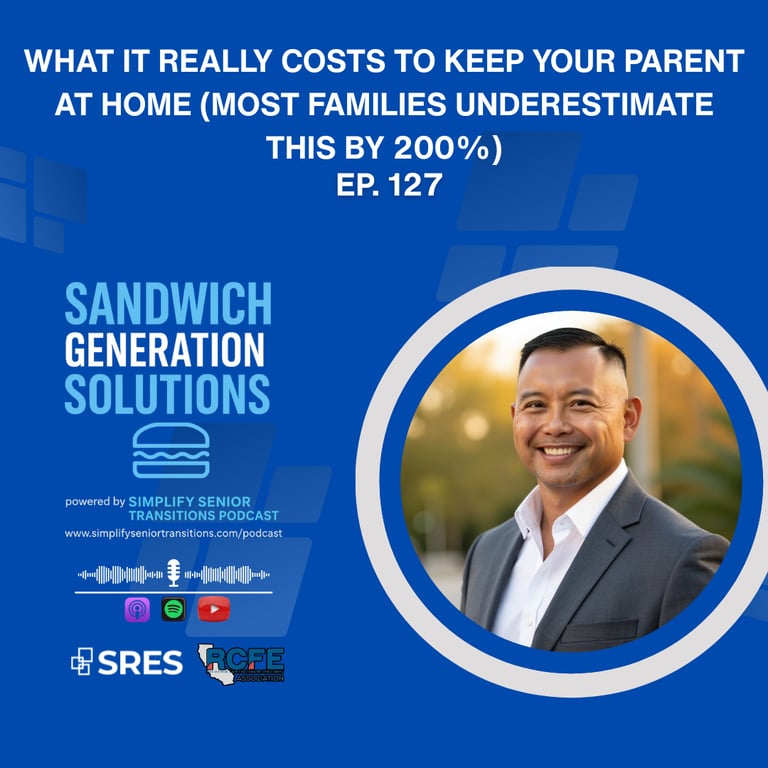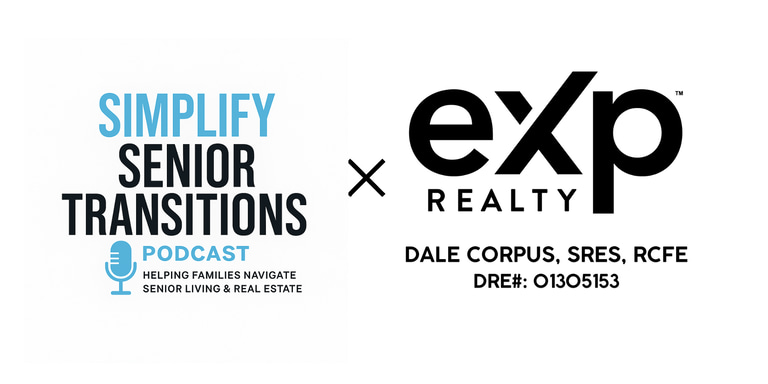The Hidden Math of Bay Area Caregiving: Why Home Isn’t Always Cheaper
The financial and emotional toll of aging in place in the Bay Area
Dale Corpus
11/22/20253 min read
Bay Area Caregiving: Why Staying Home Might Cost 200% More Than You Think
If you’re juggling your career, family life, and the increasing needs of an aging parent here in the San Francisco Bay Area—whether you’re in Contra Costa, Alameda, Santa Clara, or anywhere from Solano to Napa—you are officially part of the Sandwich Generation, and you are not alone.
When your parents say they want to age in place, it sounds like the safest, most affordable, and most loving choice.
But what if that choice is actually costing you 100%, 200%, or even 300% more than you realized—financially andemotionally?
In a recent episode of the Simplify Senior Transitions Podcast, I broke down the hidden costs of home care that most Bay Area families don’t discover until they are absolutely overwhelmed.
Here’s what you'll learn in this episode
This episode dives into why families commonly underestimate home care expenses by 200%—and what the real cost of home care is here in the Bay Area.
We explore:
Hidden expenses families often forget
The emotional toll on adult children
When home care works best
When it becomes unsafe
How to compare staying home vs. assisted living
A step-by-step method for running the numbers correctly
The Hidden Price of Staying Home: It’s Not Always Cheaper
The biggest myth: “Staying home is cheaper because the mortgage is paid off.”
In reality, keeping a parent at home in the Bay Area is often the most expensive option.
Consider the Rodriguezes from San Jose…
What began as a few hours of care per week quickly escalated:
$6,000/month for part-time caregivers
$1,800 for grab bars and a ramp
$15,000 emergency hospital stay after a fall
Within nine months, they’d spent nearly $80,000—far more than assisted living would have cost.
Families often discover too late that staying home drains not only money, but emotional bandwidth.
Bay Area Cost Reality Check: Do the Math
Home care agencies typically charge $35–$45 per hour, sometimes more in San Francisco and the Peninsula.
Just 6 hours/day can reach $7,200 per month.
Compare that to assisted living, which averages $5,000–$8,000 per month and includes:
Meals
Social activities
Transportation
Fitness programs
24/7 safety oversight
If your parent eventually needs 24/7 care, home care can skyrocket to $25,000–$32,000+ per month.
The Challenges: Downsizing & Unexpected Expenses
Families who want to keep Mom or Dad at home often face hidden costs like:
Home Modifications
Grab bars: $200–$500
Stair lifts: $2,000–$10,000
Accessible bathroom remodels: $15,000–$30,000
It’s common for upgrades to total $10,000–$40,000.
Transportation & Medical Equipment
Rental of hospital beds and lifts, plus long hours spent driving to:
Appointments
Pharmacies
Urgent care
Lost Income
Many adult children cut work hours—or leave jobs entirely.
This unseen cost is one of the most financially devastating.
Managing Emotional Stress & Burnout
Caregiver burnout is real.
Adult children often become:
Nurse
Chauffeur
House manager
Crisis responder
Your parent may be safe at home,
but are you?
Burnout affects marriages, jobs, health, and mental wellbeing.
When Home Care Is No Longer Safe
It’s time to reassess if:
There are multiple falls
One adult child is doing 90% of the work
Home care exceeds $8,000–$10,000/month
Nighttime confusion increases
Siblings are overwhelmed or arguing frequently
When the Rodriguezes moved their mom into a community in Campbell, she gained safety, activities, and medication management—while her kids regained the ability to be her children again.
Making the Right Choice with Clarity
Don’t assume home care is cheaper—do the math first.
If you’re overwhelmed, start with:
Add all current costs (not just caregiver wages).
Project future needs for the next 1–2 years.
Compare home care vs. assisted living side-by-side.
Factor in your own time, health, and burnout.
Talk to a transition specialist before a crisis hits.
If your loved one is considering senior living and you need to figure out what to do with their home—preparing it for sale or determining how it fits into the transition plan—I’m here to help.
👉 Schedule a FREE consultation:
www.simplifyseniortransitions.com
👉 Listen to the full episode of Sandwich Generation Solutions on the Simplify Senior Transitions Podcast.
👉 For quick questions, DM me on Instagram @soldbydale.
P.S. Have a story to share? Email us at dale.corpus@exprealty.com and you might be featured in a future episode!
Always check the transcript for detailed insights.
Watch The Podcast Here



Transitions Made Simple
Helping seniors transition with ease and peace.
📍 Serving the San Francisco Bay Area
📞 Get in Touch
📬 STAY INFORMED
Dale Corpus, SRES, RCFE
📱 925-380-1657
🕓 Available for free 15 min consultations by appointment
© 2025. All rights reserved.
Sign up for monthly senior transition tips & real estate insights.
